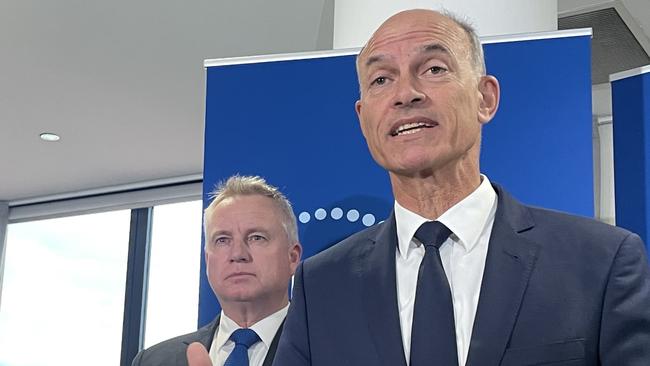Tasmanian budget: Debt doubled, asset sales and funds for AFL stadium
The state budget has deficits as far as the eye can see, flags asset sales and cuts public servants. But the Hobart AFL stadium funding is locked in.

Tasmania’s minority Liberal government will double state debt while funding a new AFL stadium and increase spending while running deficits for the foreseeable future.
The Rockliff government will allow net debt – negligible when the Liberals came to power in 2014 – to further balloon, from $5.26bn this financial year to $10.78bn in 2028-29.
New Treasurer Guy Barnett’s first budget includes $615m for the controversial $945m Hobart AFL stadium, with a further $343m in debt expected, barring further cost blowouts.
The budget allocates $300m for a second power interconnector to Victoria – despite conceding it may never eventuate – and an extra $940m to address the state’s failing health system.
Mr Barnett claimed the budget offered a “sensible pathway to surplus” but there are no surpluses in the four budget years, and no end to spiralling debt.
A net operating deficit of $1.28bn in 2024-25 is a blowout of almost $500m from original estimates, casting doubt on the government’s ability to deliver promised reducing deficits, set to shrink to $236m by 2028-29.
A razor gang and public service hiring freeze will cut $150m in spending a year, while there is an ultimate aim to reduce the public service by 2500 jobs.
However, the overall trend towards increased spending and bigger budgets – 67 per cent funded by federal taxpayers – continues.
Total spending will be higher in 2028-29 – $10.33bn – than the $10.22bn spend in 2024-25.
Privatisation of key energy, transport and port assets is being considered but Mr Barnett would not say when decisions would be made.
The Treasurer also refused to commit to using the proceeds to pay down debt – rather than pork barrelling at the next election, due in 2028.
Treasury forecasts growth – gross state product – to dip from 2.25 per cent in 2024-25 to 1.5 per cent from 2025-26, but increase to 2.5 per cent from 2027-28.
Employment is also tipped to grow by 1.25 per cent from 2027-28, although the participation rate is stalled and unemployment forecast to tick upwards to 4.5 per cent from 2026-27.
On a bright note, Treasury expects population growth – held back in recent years by a net outward flow of Tasmanians to the mainland – to improve, rising from 0.5 per cent in 2024-25 to 0.7 per cent from 2027-28.
The government appeared confused about when it would start paying down the record debt.
Mr Barnett, whose predecessor Michael Ferguson quit over the bungling of ferry infrastructure, said the $10.46bn budget “gets the balance right”.
“It addresses the key concerns in our community – cost of living, health and housing, while also keeping Tasmanians safe,” he said.
“It continues to ensure we have a strong economy by backing business and economic growth.”
He argued the historically high level of debt, which has concerned economists, was “manageable and necessary”, expressing optimism that a surplus could be delivered in 2029-30 – outside the budget period – if not earlier.
Key new spending includes $1bn for health, focused on hospital demand pressures, including elective surgery and extending home and community care programs.
There is also more than $150m more for education and $100m extra for police. Overall, the budget stated health spending increases 12 per cent, education by 5 per cent and public order and safety by 7 per cent.
Cost-of-living measures include a $60 credit on power bills, half-priced bus fares for schoolchildren and regional passengers, and food relief.
Housing measures include ongoing stamp duty relief for first-home buyers – of up to $28,000 – and a scheme allowing young Tasmanians to share equity in new homes with the government.
Mr Barnett ruled out selling a host of public assets, including racing industry bodies, TasRail, ferry operator TT-Line, and Hydro Tasmania.
However, he left wide open the later sale of other key assets, including power transmission company TasNetworks and energy retailer Aurora, as well as the state ports operator.
Labor said the budget was “the worst in the state’s history”. “When the Liberals came to office in 2014, Tasmania had $208m in net cash and investments,” Labor Treasury spokesman Josh Willie said.
“Now, after 11 years of Liberal budget mismanagement, Tasmania is on track to have the worst finances in the country and rack up nearly $10bn worth of net debt.”






To join the conversation, please log in. Don't have an account? Register
Join the conversation, you are commenting as Logout